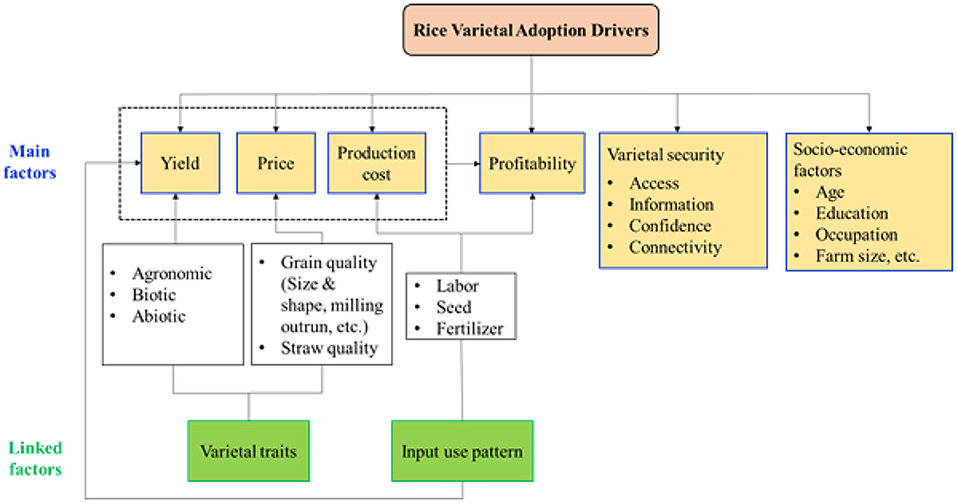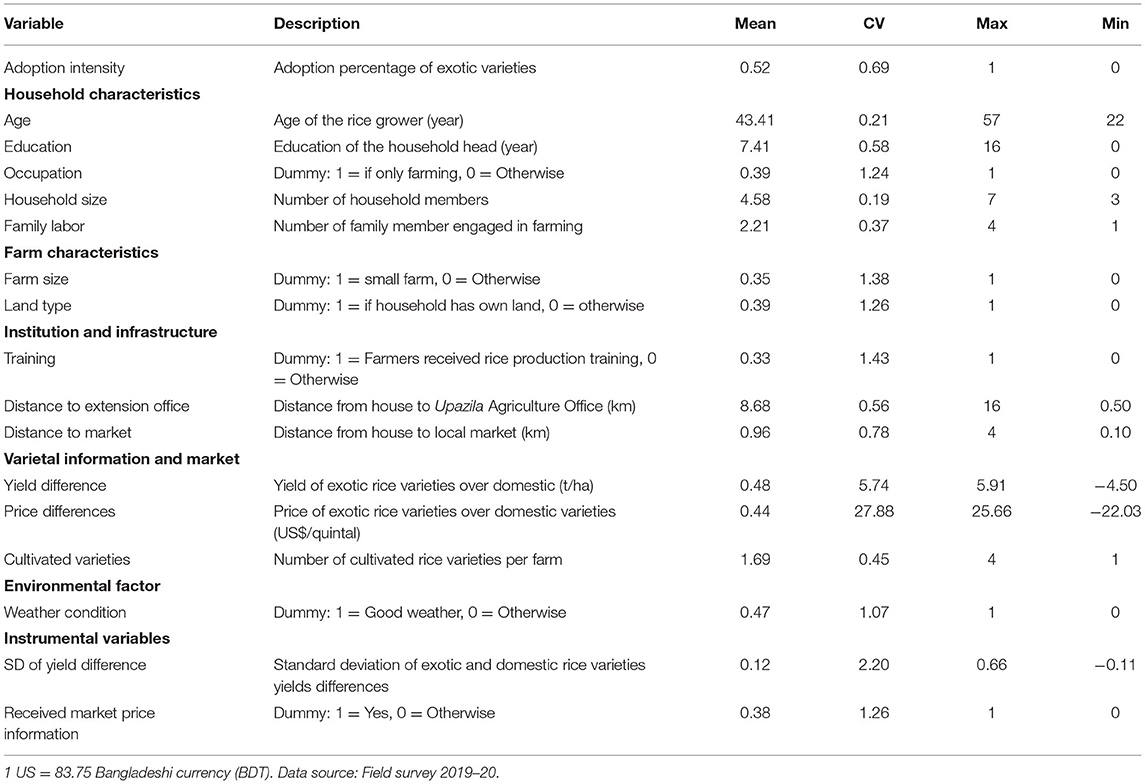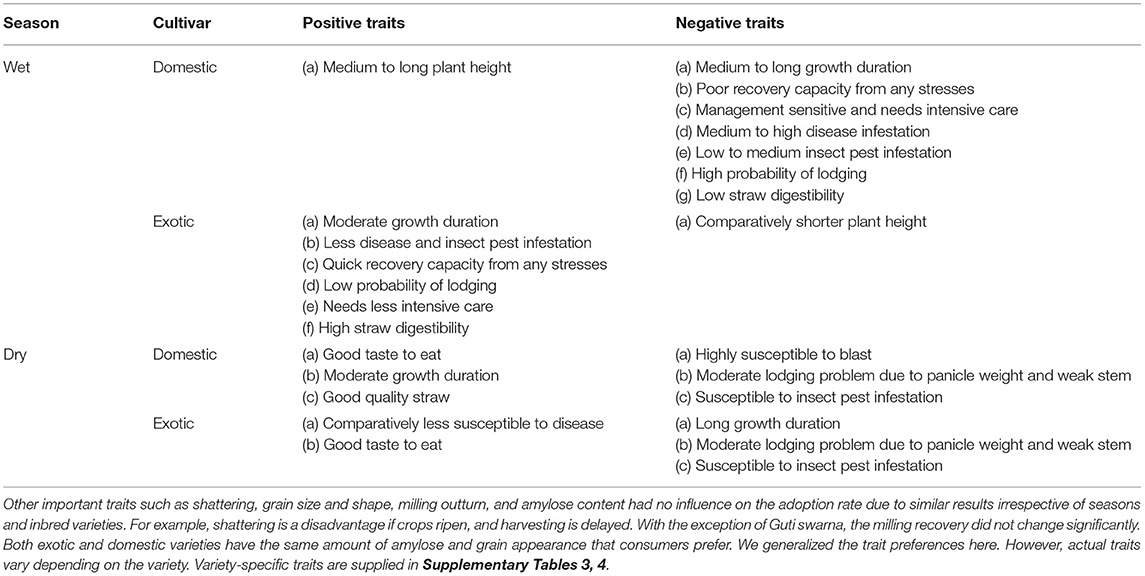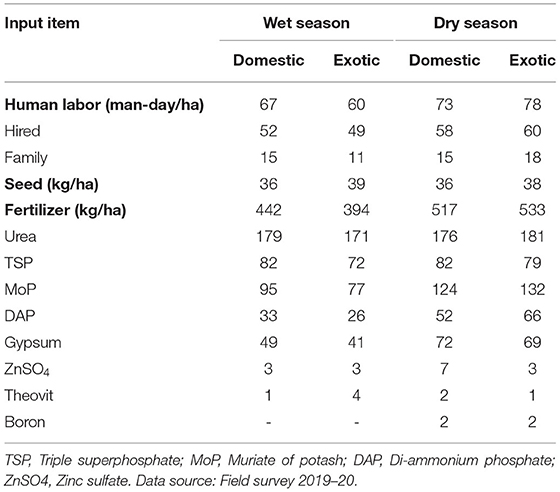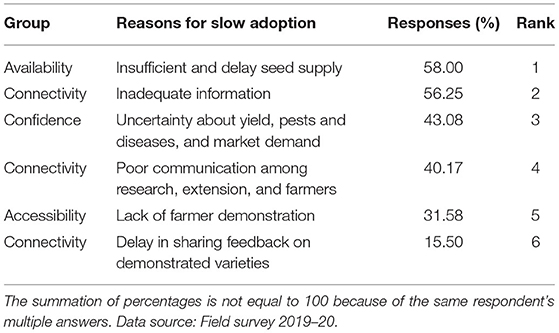- 1School of Economics, Zhongnan University of Economics and Law, Wuhan, China
- 2Agricultural Economics Division, Bangladesh Rice Research Institute, Gazipur, Bangladesh
- 3Department of Agricultural and Applied Economics, University of the Philippines Los Baños, Los Baños, Philippines
- 4International Rice Research Institute, Los Baños, Philippines
- 5Bangladesh Rice Research Institute, Gazipur, Bangladesh
Agrarian Bangladesh relies heavily on rice. Since independence, many varieties have been released and targeted to increase productivity, farmers' income, and food security. However, few gained widespread adoption. Moreover, farmers in the border regions are adopting exotic cultivars, and it's gradually spreading throughout the country. But, the reasons for adopting exotic rice cultivars are still unexplored. Using field data from 1,260 farm households and 42 focus group discussions, this study analyzes farmers' preferences for domestic and exotic rice varieties and identifies the factors of adoption linked to design national breeding programs and farmers' welfare. Findings show, exotic varieties (69%) monopolized the area coverage in the dry season, whereas in the wet season, domestic varieties (58%) dominated. Farmers select exotic varieties for their better yield and price, low production costs, high grain quality, resistance to pests and diseases, and ability to withstand stresses. Risk analysis shows domestic varieties adoption is riskier with lower returns. The empirical findings indicate that household characteristics, access to institutions and infrastructure, varietal characteristics, and weather condition, all play a significant role in adoption decisions. National breeding should focus on developing rice varieties in response to market demands and farmer preferences toward sustainable food security in Bangladesh.
Introduction
Adoption of new agricultural technology lays the groundwork for long-term agricultural growth and increasing food security (Chandio and Yuansheng, 2018). Technology adoption is heavily influenced by farmer access to inputs and receiving an adequate return on investment. Irrigation, improved seeds, fertilizers, and pesticides technologies collectively known as the “Green Revolution,” have long played a key role in the intensification of agricultural production in Bangladesh (Hazzel, 2009). In the early 1970s, Bangladesh faced a severe food shortage. Millions of people died of starvation and malnutrition in the 1974–75 famine (Muqtada, 1981). However, the situation was averted through the adoption of green revolution-era technologies. Bangladesh has made significant progress in rice production due to farmer adoption of high yielding varieties (HYVs) (Ahmed et al., 2016). In this context, the country has achieved rice self-sufficiency in 2008 and contributed to the nation's food security (Kabir et al., 2020). Indeed, in Bangladesh, “Rice security” is equated with “Food security” (Brolley, 2015).
Bangladesh is the third-largest rice producer in the world (Rahman et al., 2021). Rice is the leading staple food in Bangladesh, accounting for more than 80% of total food supply, and provides 66% of total protein requirements for daily food intake (Rahaman et al., 2020). Rice is grown on 11.4 million hectares of land, accounting for 77% of total cropped area and yielding 36.6 million tons of rice per year (BBS, 2020a). The three rice growing seasons, known as pre-monsoon (mid-March to mid-July), wet (mid-July to mid-December), and dry (mid-December to May), account for ~8, 39, and 53% of total rice production, respectively, and have nearly supplied the rice required to feed 169 million people in Bangladesh (Agricultural Diary, 2020; BBS, 2020a).
Farmers in Bangladesh grow a wide range of rice varieties, including exotic varieties. Exotic varieties contribute a significant portion of the country's rice production, and the aggregate contribution of rice to the national economy is about 4.5% (BBS, 2020b). In fact, exotic varieties account for 15.39% of total rice production (DAE, 2021). Poor documentation and proper recognition of the contribution of exotic varieties remain research gaps, which this study aims to fill. To date, 134 rice varieties have been developed, with 106 developed by the Bangladesh Rice Research Institute (BRRI), 22 developed by the Bangladesh Institute of Nuclear Agriculture (BINA), and six from different universities (BINA, 2021; SCA, 2021). However, due to many constraints, such as proper seed distribution to farmers, rice production in the country is limited to a few varieties (Siddique, 2016). Farmers in the border region of Bangladesh have been cultivating exotic varieties since 1999 (BRRI, 2016). The adoption rate of exotic varieties has increased because of population growth, rapid human mobility, environmental change, and the exchange of more goods and materials (Bryan, 1996; USBC, 2001).
In 1998–99, the government of Bangladesh decided to import hybrid rice seeds from abroad for on-farm trials to increase farm productivity. In response, about 600 metric tons of seed from four varieties in India and one variety in China were imported via public-private partnership (Husain et al., 2000). Farmers in the northwest region unofficially adopted some Indian rice cultivars through cross-border seed exchange (Kabir et al., 2019). Swarna, for example, was developed in Andhra Pradesh, India, in 1982 and is being gradually adopted in the Rajshahi district since 1999 (Tiongco and Hossain, 2015). According to BRRI (BRRI, 2020), exotic varieties accounted for approximately 6%, 10%, and 22% of total pre-monsoon, dry, and wet season rice areas in 2019–20, respectively. Questions arise, such as why exotic varieties are being adopted at such a rapid rate. What factors influence the acceptance of exotic cultivars?
Exotic varieties, without a doubt, contribute to food security and farmer welfare in Bangladesh; however, domestication of these cultivars poses a direct threat to the security and stability of national varietals. In the United States, for example, exotic species (corn, rice, wheat, soybeans, etc.) are consumed by nearly all people due to rapid domestication and are subject to environmental and economic costs (Pimentel et al., 2005). The replacement of native cultivars by non-native cultivars leads to a dramatic decrease in the genetic diversity of domestic crops (Pathaichindachote et al., 2019). Also, domestic rice cultivars are valuable genetic resources for future varietal improvement programs intended for the agro-climatic environment. Moreover, the informal trade of varieties may not have been subjected to plant quarantine, posing a risk of pest and disease transmission. It also does not ensure compliance with national seed standards such as quality, purity, and minimum germination rate. Therefore, it is critical to provide cultivar reference information for future national rice breeding plans and related policies to prevent genetic erosion.
This study aims to establish guidelines for national rice breeding programs for the development of new varieties, with an emphasis on the traits of exotic varieties that farmers prefer in Bangladesh. Despite the issue being important for its implications for domestic varietal security and local biodiversity conservation, there have been few studies on it (Kabir et al., 2019). We have addressed the gap that previous studies overlooked. The study first looks at the adoption status of both exotic and domestic varieties in the study areas. Second, identify the primary drivers affecting farmers' preferences for exotic and domestic rice varieties. Third, determine the factors influencing the adoption intensity of exotic rice varieties using an econometric model. Finally, the study made policy recommendations to assist the national breeding program in developing and disseminating future domestic rice varieties in Bangladesh to increase farmers' welfare and ensure food security.
Materials and Methods
Study Area and Sample Distribution
This paper is based on field survey data collected in 2019–20. Sampling was done using multistage random sampling. In the first stage, a purposive sampling technique was used to select the study location in Rangpur and Bogura districts of Bangladesh, where the adoption intensity of exotic rice varieties is higher. The study thoroughly covered all Upazilas in both districts to ensure that the data was statistically representative (Supplementary Table 1). In the second stage, as a result, two unions were randomly selected from each Upazila, and from each union 30 rice farmers were selected by random sampling. Therefore, a total of 1,260 rice farmers were interviewed (Figure 1).

Figure 1. Sampling distribution in the study areas according to location and survey methods. KII and FGD denote key informant interview and focus group discussion, respectively. Upazila is an important unit in the administrative system, which is formed with a few unions. Union is the lowest administrative unit in the rural area.
Before conducting the farmers' survey, we consulted with the Upazila extension personnel about the seasonal adoption status of existing rice varieties in two districts. Based on the higher adoption intensity of exotic varieties, we chose Rangpur district for wet season, and Bogura district for dry season data collection. The study employed both quantitative and qualitative research methods, such as questionnaire surveys and focus group discussions. A semi-structured questionnaire was used to survey 1,260 farmers. To validate the survey results from each union, 42 focus group discussions (FGDs) were conducted. Ten stakeholders from each union were randomly chosen for the FGDs. These stakeholders included peer farmers, local representatives, teachers, and Non-Government Organizations (NGOs) personnel. The survey covered a wide range of variables related to socio-demographics and input usage patterns.
Rice Cultivars
Total 37 rice cultivars are reported by the farmers (Supplementary Table 2). During the wet season, a total of 23 cultivars are grown, with the majority being domestic varieties. In contrast, 14 varieties are grown in the dry season, with nine being domestic and only five being exotic.
Conceptual Framework
Factors influencing rice adoption can be farm-specific, variety-specific, or location specific. According to the literature, farmers' choice of adoption is influenced by yields, price, household, and economic characteristics (family size, income), grain quality, production risk, transaction costs, consumption preferences, marketing requirements, use of new technology (e.g., modern variety), institutional program and market factors (e.g., credit availability, extension service), environmental conditions (climatic, pest, and agronomic characteristics), etc. (Bose et al., 2000; Mottaleb et al., 2014; Ghimire et al., 2015; Laborte et al., 2015; Tiongco and Hossain, 2015; Ahmed et al., 2016; Chandio and Yuansheng, 2018; Kabir et al., 2019). Figure 2 depicts a stylized representation of the drivers of rice varietal adoption based on information gathered in the study areas. Farmer's decision is influenced by six major factors: yield, price, input cost, profitability, varietal security, and socioeconomic aspects. Also, two link factors, varietal traits and input use, directly influence the main factors of variety adoption decisions. Formulating a national breeding program by incorporating these varietal adoption drivers is an important instrument for increasing farmers' income and ensuring a sustainable food system. The details of the factors are discussed in the results section.
Analytical Technique
Risk Assessment
A stochastic simulation was built for assessing the implications of uncertain events such as predictable and unpredictable externalities, and market uncertainties of rice farming to examine farmers' economic viability (Anderson and Dillon, 1977; Hardaker et al., 2004; Chavas et al., 2010). In this study, the @RISK Program Version 7 with Microsoft Excel via Monte-Carlo simulation was run for simulating risk-return trade-off between domestic and exotic rice varieties in wet and dry seasons. For the simulation, we assumed triangular probability distribution and generating cumulative probability distribution functions for the gross margin of rice farmers (Hardaker et al., 2004). In this case, the study is incorporating the distribution of yield and price by the best, typical, and worst seasonal yields, and maximum, most likely, and lowest prices of two types of rice varieties. In total, 10,000 iterations were run for the simulation to ensure the stability of the distribution of risk and return trade-off (Lien, 2003).
Empirical Econometric Approach
Aside from theoretical understanding, this study also presents an econometric model of factors affecting farmers' adoption decisions on exotic rice varieties. Before performing any inferential analyses, we ran diagnostic tests on the regression model. There was no evidence of severe multicollinearity in the model, as the mean variance inflation factor was 2.32. To determine the effect of independent variables on the adoption intensity of exotic rice varieties over domestic, we use a fractional logistic regression model originally proposed by Papke and Wooldridge (1996). When the explanatory variables are fractional in nature (have values between 0 and 1), a linear model is ineffective (Papke and Wooldridge, 1996; Mullahy, 2015) for examining the farmers' adoption decisions. Aryal et al. (2018) and Branca and Perelli (2020) analyzed farmers' adoption of new technologies and practices in agriculture using a fractional regression model. However, the frictional logistic regression automatically removed the heteroscedasticity problems in the model by giving robust standard errors.
The conditional expectation of the fractional response variable model proposed by Papke and Wooldridge (1996) has the following structure:
Where, 0 ≤ Yi ≤ 1 indicates the dependent variable, Xi is a set of explanatory variables and G(.) is a known function satisfying 0 < G(z) < 1. Typically, G(.) is chosen to be a cumulative distribution function with the logistic function link as G(z) = exp(z)/[1+ exp(z)].
In this paper, we use a logistic functional form to ensure that the predicted values of the dependent variable are between zero and one, and a particular quasi-likelihood method, which maximizes Bernoulli log-likelihood function. Following McCullagh and Nelder (1989) and Papke and Wooldridge (1996) propose the Bernoulli log-likelihood function as:
Papke and Wooldridge (1996) provide robust estimators of the asymptotic variance of β based on the well-known sandwich formula and the non-linear conditional mean G(.).
Following the discussion of the estimation techniques, the quasi-MLE model is specified as:
Or
Where, Yi = Adoption percentage of exotic varieties, E1i = Yield of exotic rice varieties over domestic (t/ha), E2i = Price of exotic rice varieties over domestic varieties (US$/quintal), X1 = Age (year), X2 = Education (Year), X3 = Occupation (1: Only farming), X4 = Household size (no.), X5 = Family labor (no.), X6 = Small farm (1: Yes), X7 = Own land (1: Yes), X8 = Training received (1: Yes), X9 = Distance to extension office (km), X10 = Distance to market (km), X11 = Number of cultivated rice varieties per farm, X12 = Good weather (1: Yes), and εi is an error term.
In this study, there could be issues of reverse causality, where devotion to land in exotic rice varieties would make farmers more productive and more price responsive, thus possibly contributing to higher levels of adoption. Moreover, the control variables of Xi in Equation 4 that influence the possible endogenous variables (E1i and E2i) in the model, and there is no correlation between E1i and εi and E2i and εi. In this case, fractional logistic regression would produce unbiased estimates of β1 and β2 and there are unobserved factors that jointly influence E1i and Yi and E2i and Yi, leading to endogeneity bias. Lastly, measurement error could be a source of endogeneity, despite our efforts to acquire high-quality data.
To address the endogeneity problem in the model, we account for using the two-stage IV control function approach (CFA) proposed by Wooldridge (2015). Since the endogenous variables, E1i and E2i are continuous in nature, we estimate the first-stage regression using an ordinary least square model in Equations 5 and 6.
Where, I1i and I2i are instrumental variables, namely standard deviation of exotic and domestic rice varieties yields differences, and received market price information, respectively. δ and α are the regression coefficients, and v1 and v2 is the residuals of first-stage regression model.
This is important to obtain consistent residual predictions from Equations 5 and 6 for use in the second-stage regression. A statistically significant coefficient of the predicted first-stage residual term would imply that the model has an endogenous problem. To correct this, we added two residuals of first-stage regression into the second-stage generalized linear regression model (GLM) with a binomial family and a logit link using quasi-MLE (Papke and Wooldridge, 1996).
For the endogeneity test, the estimated Wald Chi-square values of residual of yield difference and residual of price difference at first-stage regression are highly significant (p < 0.01). Additionally, our estimated joint Wald Chi-square value is also highly significant (p < 0.01) (Table 5). That means, two variables (yield difference and price difference) are endogenous in the model.
In this study, we found a single valid instrument for each endogenous variable. So, there is no specific instrument exogeneity test for a single valid instrument. But for the instrument relevance test, we found that the estimated F-value in both the instruments is >10 and significant at 1% level (Table 5). That means, our instruments in the model are valid and strongly correlated with the endogenous variables.
Descriptive Statistics
Table 1 lists the variables used in the econometric model, along with their units of measurement. As observed, the average rate of adoption of exotic rice varieties was 52%. The average age of the rice farmer was 43 years, and they had an average of 7 years of education. Farming was the only source of income for 39% of respondents, and on average, 2.21 persons per family were involved in farming. The respondents' average family size (4.58 no.) was close to the national average of 4.5. Around 35% of respondents were small farmers, while the remaining farmers were classified as medium, and/or large. Nearly 39% of farmers, however, cultivate their own land.
About 33% of the respondents received rice production training. On average, they cultivated 1.69 varieties per farm. The average distances from farm households to the extension office and nearby markets were 8.68 and 0.96 km, respectively. Yield of exotic rice varieties over domestic was 0.48 ton/ha, with a market price differential of 0.44 US$/quintal in favor of exotic varieties. Although the average price difference is low, the coefficient of variation explained higher price variability. About 47% farmers reported favorable weather for rice cultivation in the study period. Nearly 38% farmers received rice price information from the market.
Results
Ten Years' Adoption Status of Exotic and Domestic Cultivars
This study investigates the last 10 years' domestic and exotic varieties' adoption patterns. Figure 3 shows that the rate of domestic varieties area coverage in wet season has decreased from 78% in 2011 to 58% in 2019. On the contrary, there has been a sharp increase in the area coverage of exotic varieties from 22 to 42% over the same time period. If the current trend continues, exotic varieties will soon outnumber domestic varieties, which is a major concern for domestic varietal security. Based on FGDs, the exotic rice variety called “Indian swarna” was first introduced in 2003 for the wet season in the Rangpur district. They quickly gain popularity among farmers and currently, various Upazilas in the district are cultivating various Swarna rice varieties (i.e., Guti swarna, Mamun swarna, Ranjit Swarna, Parija, etc.).

Figure 3. Ten years (2010–11 to 2019–20) adoption status of wet and dry season rice varieties. “***” Denote 1% level of significance. Data source: Upazila agriculture office, Rangpur and Bogura, Bangladesh.
Dry season exotic varieties were found to dominate in the Bogura district (Figure 3). Adopting exotic varieties is increasing at a 5.88% rate, and area coverage has tripled in the last ten years. Following this, domestic variety area coverage rate had decreased from 80% in 2011 to 31% in 2019. Based on FGDs information collected, “Indian Zira” was introduced in the Bogura district during the dry season in 2000. Farmers began cultivating exotic varieties such as Zira, Khato-10, Moazzem zira, Parija, and Sampa katari in all upazilas. In 2016, a severe blast of the domestic mega rice varieties BRRI dhan28 and BRRI dhan29 caused significant yield loss in the country's north and the northwest region. Following 2016, farmers began to lose faith in domestic varieties and start to heavily adopt exotic varieties. The details of Upazila wise current adaptation status are in Supplementary Figures 1, 2.
Drivers for Adopting Exotic Varieties: A Cognitive Approach
Yield Advantage
In wet season (Figure 4), the domestic hybrid Dhanigold (5.45 t/ha) has the highest yield, followed by Hira-2 (5.05 t/ha), ACI (4.93 t/ha), Guti swarna (4.54 t/ha), BRRI dhan49 (4.41 t/ha), BRRI dhan52 (4.38 t/ha), and so on. However, the exotic inbred Guti Swarna (38.91%) had the highest adoption rate followed by domestic varieties BR11 (17.59%), BRRI dhan52 (12.90%), BRRI dhan49 (5.19%), and so on.
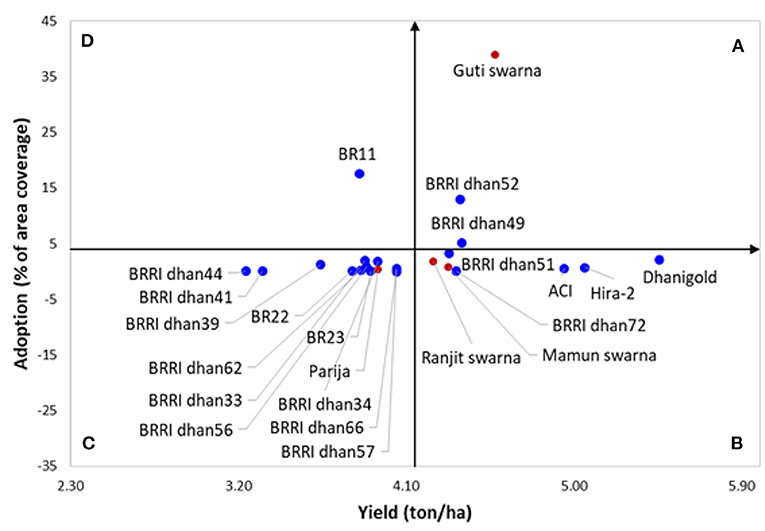
Figure 4. Interaction effects of adoption rate and yield of wet season rice varieties. Blue color dots indicate domestic cultivars, and red color dots indicates exotic cultivars. The English alphabet presenting “A, Higher yield vs. higher adoption zone; B, Higher yield vs. lower adoption zone; C, Lower yield vs. lower adoption zone; and D, Lower yield vs. higher adoption zone.
The combined effect of yield and adoption rate is depicted in each zone of Figure 4. The adoption rate of Guti swarna, BRRI dhan49, and BRRI dhan52 is higher in zone A, owing to comparatively higher yield given the rapid recovery stress, seed availability, and good taste. Conversely, the adoption of BR11 (Zone D) was higher than that of BRRI dhan49 and BRRI dhan52 (owing to good eating quality) despite the yield was significantly lower at only 3.85 t/ha. This is due to a genetic potential that decreased after being cultivated for a long time, a factor that is compounded by its susceptibility to sheath blight disease and Brown Plant Hopper (BPH) infestation. Other varieties had high yield potential (Zone B), but a number of factors, including poor grain quality, farmers' inability to save seeds for the following planting season, and a scarcity of high-quality seed, slowed adoption. The reasons behind the low adoption and low yielding varieties (Zone C) were long growth duration (that hinders early Rabi crops), severe pest and disease infestation, and unavailability of quality seed.
In the dry season (Figure 5) domestic variety was found to dominate, BRRI dhan29 (6.90 t/ha) yielded the highest, followed by BRRI dhan58 (6.71 t/ha), Zira (6.57 t/ha), BRRI dhan28 (6.24 t/ha), Moazzem zira (6.18 t/ha), and so on. There is a significant difference in the adoption of the exotic variety Zira (70.72%) compared to the nearest adopted domestic varieties BRRI dhan28 (15.16%), BRRI dhan29 (4.76%), Khato-10 (1.36%), BRRI dhan58 (0.96%), and so on.
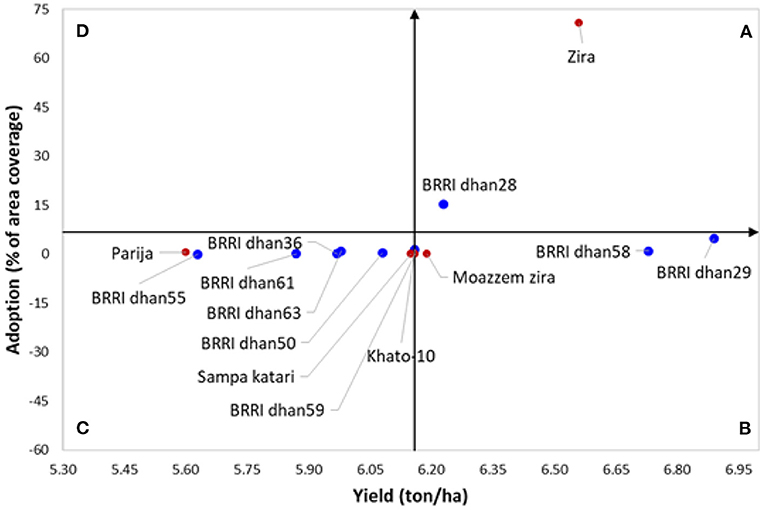
Figure 5. Interaction effects of adoption rate and yield of dry season rice varieties. Blue color dots indicate domestic cultivars, and red color dots indicates exotic cultivars. The English alphabet presenting “A, Higher yield vs. higher adoption zone; B, Higher yield vs. lower adoption zone; C, Lower yield vs. lower adoption zone; and D, Lower yield vs. higher adoption zone.
Zira (Zone A) is rapidly gaining popularity for its higher average yield difference (0.33 t/ha) than the prior mega variety BRRI dhan28, along with better grain quality and easy farm-gate transaction. However, the productivity of BRRI dhan28 has been declining over time due to its higher susceptibility to blast disease and severe lodging problems. Although BRRI dhan29 and BRRI dhan58 (Zone B) produced higher yields than other varieties, their lower adoption rate can be attributed to a longer growth period, bold grain, and a lack of quality seed. Importantly, Moazzem zira and Khato-10 had yield potentiality, but an inadequate supply of seed explained their low adoption rate. Rest of the varieties in Zone C had lower yields with low adoption rates because of their high susceptibility to blast disease, bold grain, and scarcity of quality seed.
Price Variation
In wet season (Figure 6), the average farm-gate price for domestic BRRI dhan34 was found to be the highest (43.50 US$/quintal), followed by BRRI dhan49 (25.59 US$/quintal), Guti swarna (25.15 US$/quintal), BR11 (24.71 US$/quintal), Mamun swarna (24.13 US$/quintal), and so on. BRRI dhan34 has a higher price for its aroma and grain quality, but it has a lower adoption rate because the average consumer prefers non-aromatic parboiled rice.
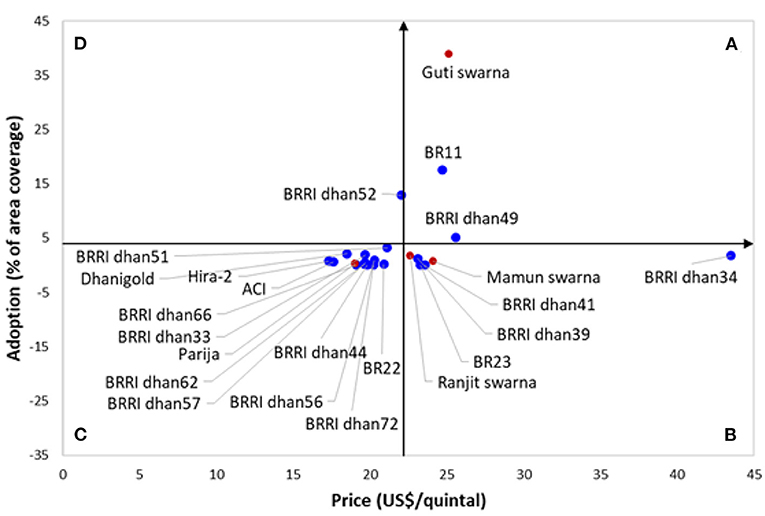
Figure 6. Interaction effects of adoption rate and market price of wet season rice varieties. Blue color dots indicate domestic cultivars, and red color dots indicates exotic cultivars. The English alphabet presenting “A, Higher price vs. higher adoption zone; B, Higher price vs. lower adoption zone; C, Lower price vs. lower adoption zone; and D, Lower price vs. higher adoption zone.
The varieties Guti swarna, BR11, and BRRI dhan52 (Zones A and D) demonstrated higher market acceptance rates at the miller level for their medium bold type of grain and increased consumer demand in the southern part of Bangladesh. Besides, head rice and filled grain percentages for Guti swarna and BR11 are much higher. The higher price of domestic variety BRRI dhan49 (zone A) for its “Naizershail” (a popular consumer brand with huge market demand) type grain and increased demand at the miller level. Also, rice processors were keen to supply milled BRRI dhan49 by the brand name of BR49, Pajam, and Nazir after grading that would allow them to derive a price advantage of up to 5.97 US$/quintal. The adoption rate of BRRI dhan49 was comparatively lower than that of Guti swarna (Zone A) mainly because it is highly susceptible to false smut disease. Although Zone B varieties are low adopted, exotic varieties Mamun swarna and Ranjit swarna have the potential to expand their coverage area due to their better grain quality and higher market price. Varieties in Zone C have low adoption and market price, which is primarily explained by their inferior grain quality (stickiness).
Figure 7 shows that during the dry season, the farm-gate price of exotic rice varieties Sampa katari (28.67 US$/quintal), Zira (28.35 US$/quintal), and Moazzem zira (28.07 US$/quintal) is higher than that of domestic rice varieties BRRI dhan63 (26.83 US$/quintal), BRRI dhan50 (25.09 US$/quintal), and BRRI dhan28 (23.88 US$/quintal). Despite the high price, farmers did not widely adopt exotic varieties due to their long growth duration, high production costs, and the delays they generate in cultivating pre-monsoon season crops.
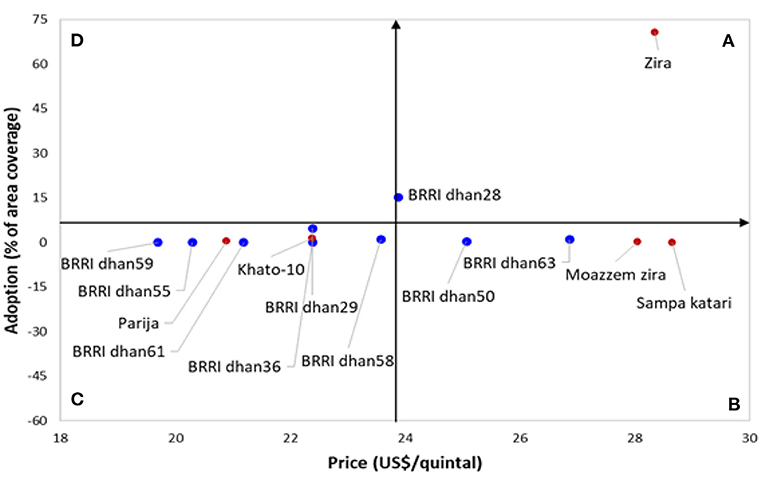
Figure 7. Interaction effects of adoption rate and market price of dry season rice varieties. Blue color dots indicate domestic cultivars, and red color dots indicates exotic cultivars. The English alphabet presenting “A, Higher price vs. higher adoption zone; B, Higher price vs. lower adoption zone; C, Lower price vs. lower adoption zone; and D, Lower price vs. higher adoption zone.
The interaction effects of adoption rate and the market price of Zira and BRRI dhan28 (Zone A) were higher, but there was a vast dispersion between these varieties. This dispersion is mainly for higher milling outturn, long slender type grain, and good taste. Long slender grain domestic varieties BRRI dhan50 and BRRI dhan63 (Zone B) obtained higher market prices, but they are susceptible to neck blast disease, resulting in a lower adoption rate. Both the market price and adoption rate of Zone C rice varieties were lower due to the relatively bold type grain, which does not sell well in the Bangladeshi rice market.
As previously stated, yield and market price are the two main drivers of exotic variety diffusion during both the wet and dry seasons. Figure 8 (left-hand panel) shows that the yield dispersion was much greater than the price dispersion during the wet season. The domestic variety BRRI dhan34 appears as an outlier. During the dry season (right-hand panel in Figure 8), however, both price and yield disperse significantly. Nevertheless, exotic varieties are found primarily in zone A during both seasons, indicating a clear association between the level of adoption and higher than average market price and yield. By contrast, most of the traditional domestic varieties exhibit low adoption rates because they embody lower yield and a lower market price (Zone C).

Figure 8. Interaction effects of yield and market price of wet and dry seasons rice varieties. Blue color dots indicate domestic cultivars, and red color dots indicates exotic cultivars. The English alphabet presenting “A, Higher yield vs. higher price zone; B, Higher yield vs. lower price zone; C, Lower yield vs. lower price zone; and D, Lower yield vs. higher price zone.
Varietal Traits
Agronomic, grain quality, and pest and disease resistance traits are paramount for variety diffusion and future rice breeding programs. Although we mentioned some variety-specific trait preferences in the yield and price section, this section documents farmers' generalized trait preferences for exotic and domestic varieties. Farmers in FGDs identified the advantage of cultivating domestic varieties in the wet season as long plant height, which yields more straw (Table 2). During the wet season, the main reasons for farmers' low adoption of domestic varieties are their susceptibility to the most common pests and diseases in rice, such as sheet blight, bacterial blight, and false smut. Domestic cultivars are also more vulnerable to rat attacks that could result in severe crop damage. Under adverse conditions (cool elevated, submerge-prone, and drought-prone), domestic varieties perform poorly. Domestic cultivars also have the disadvantage of being unable to be used in cropping patterns due to varying growth duration, as well as the need for extra field care when exotics have the opposite traits.
Farmers identified domestic varieties that are good in taste during the dry season; however, the taste of exotic varieties decreases when cooked rice becomes cold and hard. The straw quality of the domestic varieties is good, and it can be sold for cattle feeding, providing farmers with extra income. In the contrary, exotic varieties have a broader spectrum of disease resistance which is the main trade-off for adoption, though they are susceptible to insect pests. A heavy panicle weight combined with a weak stem may lodging domestic and exotic varieties.
Input Use Patterns
Rice production in the wet season is less costly than in the dry season (Table 3). In wet season, domestic variety was found to be more labor intensive than exotic. The seed rate for exotic varieties was slightly higher than for domestic varieties. Approximately 63% of farmers used domestic seed obtained from formal sources such as the Bangladesh Agricultural Development Corporation (BADC) and private companies. In comparison, roughly 76% of farmers obtain exotic seeds from informal sources, such as their own or neighboring farmers, whose germination capacity is lower. However, domestic variety requires significantly more fertilizer, which accounts for a significant portion of the cost.
Turning to the dry season, exotic varieties demanded more labor for farming operations due to longer field duration. Even though domestic varieties require less seed than exotic varieties, farmers used far more seed than the scientific recommended rate (25–30 kg/ha) (BRRI, 2018). Exotic cultivars required more fertilizer than domestic varieties. To sum up, farmers used fewer inputs for domestic inbred cultivars than for exotics. According to FGD findings, farmers tended to invest fewer inputs altogether for dry season domestic rice varieties as they were losing interest in its cultivation due to higher environmental and market risk.
Stochastic Profitability
Figure 9 shows that during the wet season, the cost of producing one quintal of domestic variety is 21.43% higher than the cost of producing exotics. However, according to the Benefit-Cost Ratio (BCR), exotic varieties are an economically appealing choice for farmers. Instead of incurring losses, many farmers continue to cultivate domestic inbred for home consumption.
During the dry season, the production costs of exotic and domestic varieties are roughly equivalent, but exotic varieties are about 13% more profitable than domestic varieties. Notably, the BCR of exotic varieties is higher in the dry season (1.23) than in the wet season (1.16). The reason for this is that most farmers cultivate for commercial purposes in order to capitalize on higher exotic variety prices during the dry season.
Although farmers' adoption decisions are driven by profit maximization, they are frequently associated with taking environmental and market risks to reap the benefits. Therefore, we conducted a stochastic risk analysis and displayed the estimated cumulative probability distribution functions (CDFs) of gross margin over the last 5 years for domestic and exotic varieties in Figure 10. CDFs show that farmers have over 95% chance of having a gross margin per hectare over 264 USD for the wet season and 290 USD for dry season exotic rice cultivation. The probability of domestic rice varieties having the aforementioned gross margin decreased to 65 and 71% for wet and dry seasons, respectively. The risk analysis results indicate that the lower risk of adopting exotic varieties explains the growing trend of exotic variety diffusion in both wet and dry seasons under the current environmental and market conditions.
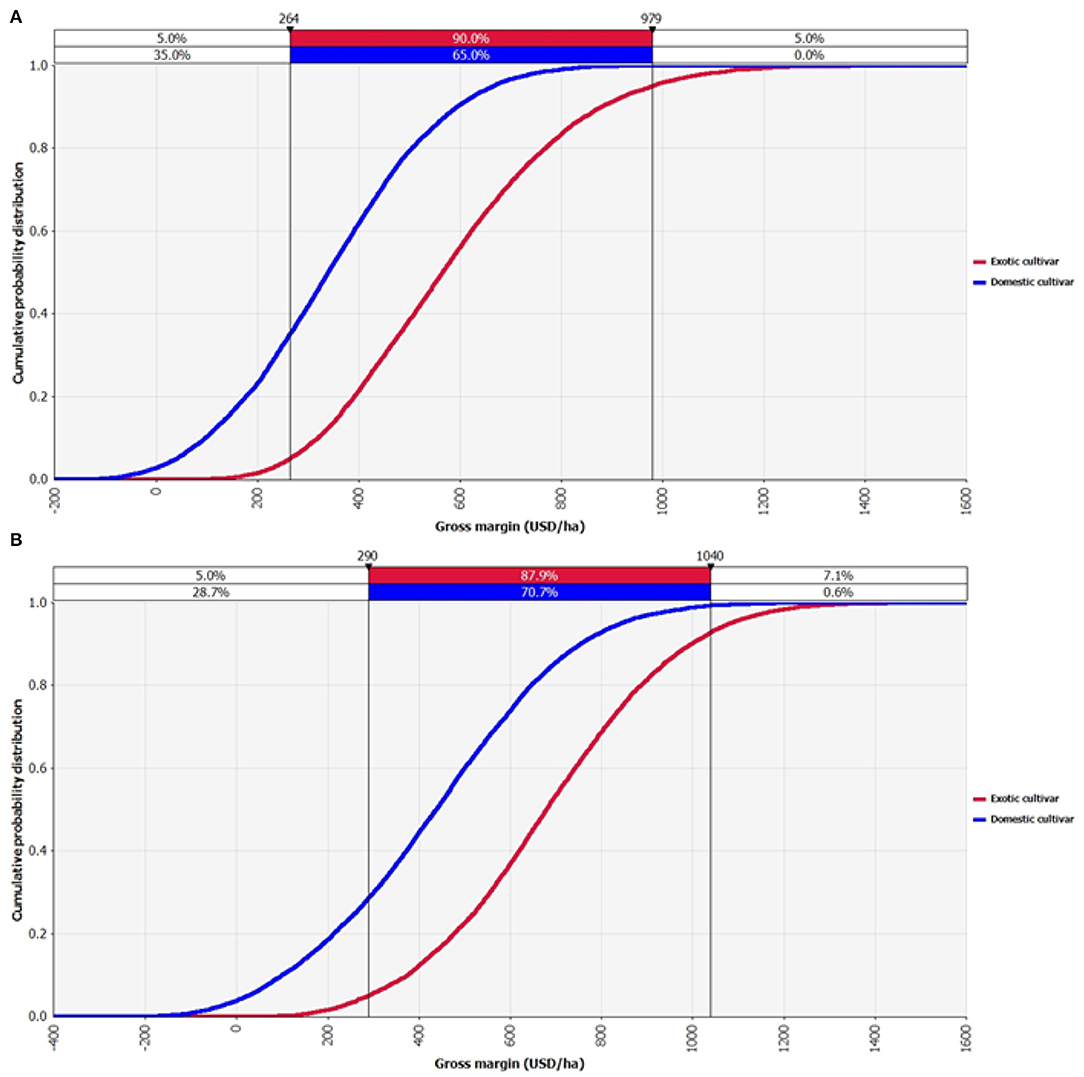
Figure 10. Cumulative probability distribution of gross margin of domestic and exotic rice in 2019–20 at farmers perceived seasonal variation in yield and price. (A,B) denote wet and dry seasons, respectively.
Varietal Security Factors
Farmers identify six major factors impeding the adoption of newly released rice varieties that are associated with production risk (Table 4). The public sector's distribution of new seeds and quality seeds is insufficient in comparison to demand (MOA, 2015) in the study areas. Small and marginal farmers are unable to collect seed because extension services are often biased toward large-scale farmers (Tiongco and Hossain, 2015). A poor connection with the extension officer makes it difficult to obtain timely information about farm operations. Lack of proper demonstration e.g., field day, leaflets, posters, pamphlets, and announcements limited farmers' access to proper information about newly released varieties. Late sharing of agronomic, grain quality, and pest and disease resistance traits frequently reverses adoption decisions. To summarize, the spread of new varieties is dependent on farmers' varietal security in terms of accessibility, availability, connectivity, and confidence.
Determinant of Exotic Varieties Adoption: An Econometric Approach
We used four different econometric models here to find out the adoption determinants of exotic rice varieties (Table 5). Model I and II are the fractional logistic regression models, which contain endogeneity issues. However, we addressed these endogeneity issues by employing two stages control function approach in Model III. For checking robustness, we bootstrapped the results with 1000 iterations in Model IV. The findings in Table 5 indicates that Model III is the robust estimation.
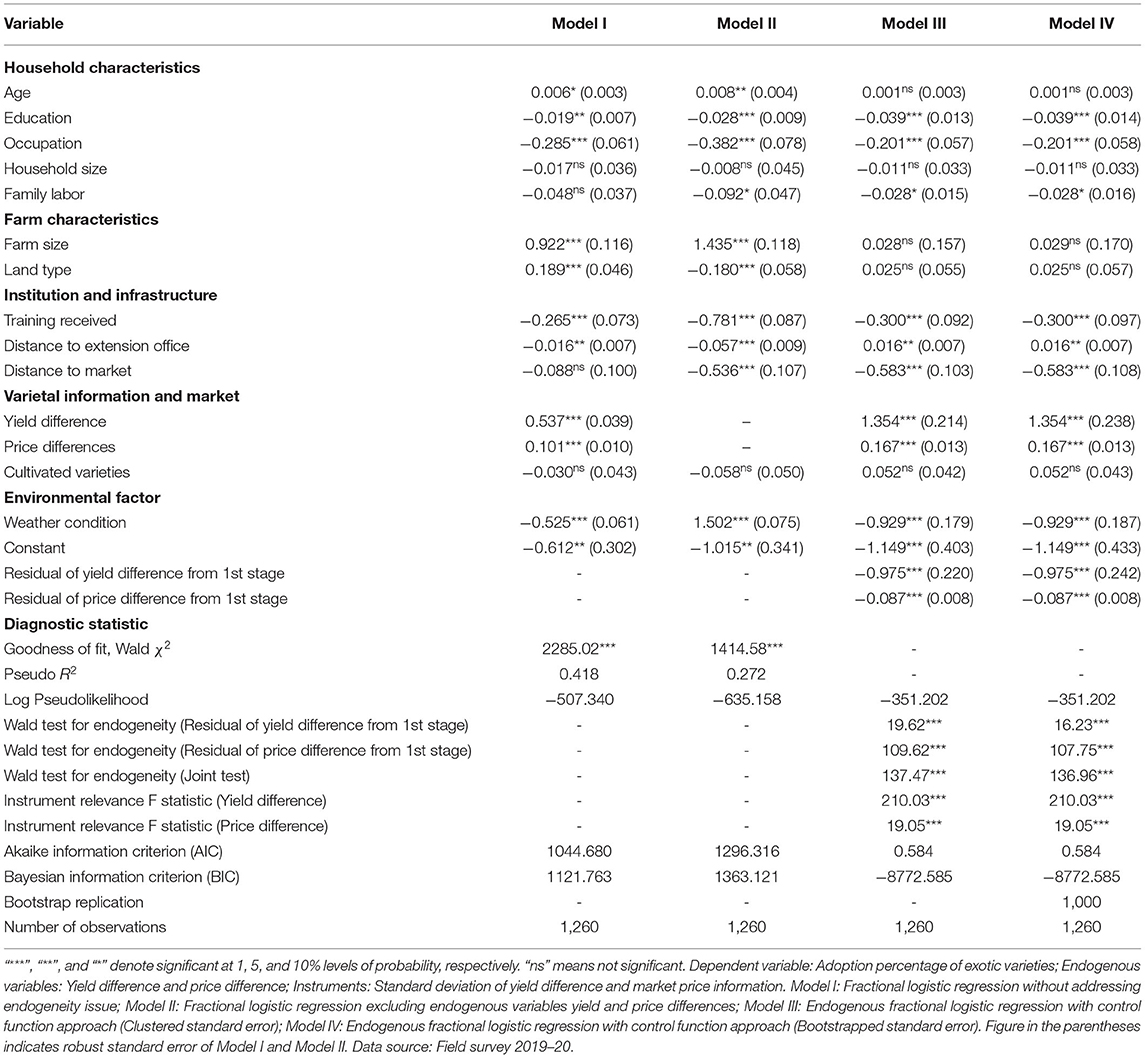
Table 5. Quasi-MLE of endogenous fractional logistic regression for adoption of exotic rice varieties.
The results reveal that the level of education of farmers has a negative impact on adoption intensity. A higher level of education encourages farmers to adopt reliable technology (domestic variety) along with increased access to information (TV, newspaper, radio, etc.) and the use of connectivity (seed dealers, extension workers) (Guarini et al., 2018; Branca and Perelli, 2020). As mentioned previously, exotic varieties require less intensive care to produce, which means that farmers who work multiple jobs have less time in the field and are more likely to adopt exotic varieties. Contrary to expectations, household members' involvement in farming is associated with a decrease in the adoption intensity of exotic varieties. A possible explanation is that the cultivation process requires less labor. As a result, they are more eager to grow exotic rice varieties than domestic varieties, not only to reduce crop failure risk (Di Falco and Chavas, 2009) but also to gain a yield advantage.
Farmer's training as the institutional network has a negative and significant effect on the adoption of exotic varieties. This is obvious, as training increased farmer access to information about the technologies and farming practices (Mariano et al., 2012; Aryal et al., 2018) of domestic varieties, as well as increased integration with extension officers. On the other hand, farmers who live farther from the extension office have fewer contacts with extension personnel and receive less information about domestic varieties, making them more likely to adopt exotic varieties. This demonstrates the importance of regular extension contact in encouraging farmers to adopt rice varieties (Ghimire et al., 2015; Chandio and Yuansheng, 2018). The distance to market as a proxy for infrastructure has a negative influence on exotic variety adoption decision. The shorter market distance reduces the transaction costs associated with transporting seeds and inputs, increases access to market information (Mottaleb et al., 2014; Aryal et al., 2018), more access to new technologies, and facilitates the sale of products. As expected for varietal traits, increased yield (Laborte et al., 2015) and price variation have a positive effect on varietal selection. The greater the yield and price, the higher the rate of adoption of exotic varieties, and vice versa for domestic varieties. A favorable environment has a negative effect on exotic rice varieties' adoption decisions. That means stress environment increases eagerness to cultivate exotic varieties. The current rice production environment in Bangladesh is more vulnerable to climate change (Ali et al., 2021), farmers are affiliated to adopt stress resilience varieties. So, this finding is strongly evidenced the current adoption nature of exotic rice varieties throughout the country.
Discussion
Bangladesh is now self-sufficient in rice production. The country has made remarkable strides in rice production since independence, tripling output in the last four decades (Anas, 2019). However, the researcher projected that the current production would fall short of meeting future food demand. By 2050, the population of Bangladesh will reach 215 million (United Nations, 2017) necessitating the production of additional 10 million tons of rice (Mainuddin and Kirby, 2015). Therefore, it is critical to select rice varieties that produce a high yield, have good grain quality, low production cost, are resistant to pests and diseases, and can withstand stresses (Mariano et al., 2012; Laborte et al., 2015; Kabir et al., 2019; Mainuddin et al., 2021). This study demonstrated that exotic rice varieties have higher yields and prices than domestic varieties. Given the fact that adoption of exotic varieties is increasing during both the wet and dry seasons. According to a study conducted in Northwest Bangladesh, exotic cultivars have diffusion rate between 76 and 85% of total wet season rice area. Farmers prefer cultivating exotic rice cultivars to avoid yield losses due to abiotic and biotic stresses (Kabir et al., 2019). Additionally, the low production costs and high profit margins enable farmers to switch (Mainuddin et al., 2021) from domestic to exotic varieties.
Food security and household welfare are two avenues by which the adoption of improve varieties may benefit farmers. Exotic varieties could provide farmers with the advantage for rice self-sufficiency and food security by increasing yield. Farmers received a higher yield hence more rice for household members (Minten and Barrett, 2008; Mainuddin and Kirby, 2015; Mansaray and Jin, 2020). Increased food consumption may benefit the food intake of the members, resulting in boost food security for the farm household. This may result in a decrease in expenditure on rice and an increase in purchasing power for other required diets. According to a study of Malawian farmers, yield stability enables households to either escape or endure stress conditions such as drought (Kassie et al., 2011). Additionally, increased production rises farmers' incomes from surplus rice sales (Arouna et al., 2017; Islam et al., 2019) which may enable farmers to provide adequate, safe, and nutritious food to their families.
Drawing from literature, improved rice varieties have a positive effect on farmers' welfare (Nguezet et al., 2011; Awotide et al., 2012; Islam et al., 2019; Mainuddin et al., 2021) that also goes for the exotic variety. Income increases could be used to lift households above the poverty line. Likewise, farmers may purchase farm assets such as machinery or livestock, enhancing the farm household's capacity to generate higher levels of future farm income (Mathenge et al., 2014; Verkaart et al., 2017). Farmers who grow exotic cultivars may thus have the potential to become better off than they were earlier.
While exotic varieties contribute to farmers' socioeconomic well-being, their widespread dissemination poses a threat to domestic cultivars. Especially, the possible risks of unauthorized exotic rice variety adoption are- erode the genetic diversity of domestic varieties, low return on investment in varietal development, transboundary disease outbreak, etc. These risks could be mitigated by developing demand driven rice varieties by the national breeders. Therefore, it is urgent to incorporate identified exotic varieties adoption traits into the national breeding program formulation. Keep this in mind, we provide policy intervention under four pillars: research, technology, extension, and market for tailoring rice varieties adoption.
• Transforming conventional breeding system into multi-stress and market-driven breeding: Rice breeders must prioritize the most relevant product profile concepts under environmental and market conditions during varietal development.
• Domestication of exotic varieties: Breeders may purify and select pure lines of the existing popular exotic varieties and release them for the concerned areas through the certification of the national seed board for minimizing transboundary disease outbreaks.
• The popular varieties can be traded between two countries through a seed exchange agreement. The “seed-without-border” initiative sponsored by the International Rice Research Institute (IRRI) and Bangladesh is a party provides a useful and ready-to-use framework in this regard.
• “Seed Village” at the farmer level recommended in Kabir et al. (2019) should be established to accelerate quality seed production and multiplication.
• The client-focused extension services should be improved by providing training to the farmers and extension personnel at the beginning of each season, enlarging effective demonstration programs, and ensuring updated knowledge and information.
• A fair farm-gate price should be offered for market stabilization.
Conclusions
Farmers in the border region of Bangladesh prefer exotic varieties that have yield advantage, higher market price, less inputs requirement, higher profitability, better agronomic qualities such as lower risks of infestation by pests and diseases, a better aptitude to fit in various cropping patterns, quick recovery capacity from stresses especially drought, less labor requirements, and other socio-economic factors such as education, occupation, and family labor. Unless new, improved domestic varieties can compete on these factors, exotic varieties will most likely continue to dominate. Researchers, policymakers, extension personnel, and farmers must collaborate to identify and develop the most viable market-driven breeding alternatives to mitigate the potential effects of an over-reliance on exotic varieties. These technologies could have remarkable impacts in accelerating farmers' welfare and sustaining food security in Bangladesh. The findings are also helpful for other rice-growing countries for the same purposes.
Data Availability Statement
The original contributions presented in the study are included in the article/Supplementary Material, further inquiries can be directed to the corresponding authors.
Author Contributions
MARS: conceptualization. MARS and JB: methodology. MCR and MI: formal analysis. MARS, MCR, and MSR: investigation. MARS, MCR, MSR, MRS, and MI: data curation. MARS, MCR, MSR, and MRS: writing—original draft preparation. MK and JB: writing—review and editing and supervision. All authors have read and agreed to the published version of the manuscript.
Conflict of Interest
The authors declare that the research was conducted in the absence of any commercial or financial relationships that could be construed as a potential conflict of interest.
Publisher's Note
All claims expressed in this article are solely those of the authors and do not necessarily represent those of their affiliated organizations, or those of the publisher, the editors and the reviewers. Any product that may be evaluated in this article, or claim that may be made by its manufacturer, is not guaranteed or endorsed by the publisher.
Acknowledgments
The authors are thankful to Mr. Md. Abdullah Al Mamun, Scientist of Agricultural Statistics Division, BRRI, for his support and comments regarding the statistical analysis. We also would like to acknowledge the students of Bangladesh Agricultural University who did a tough and valuable job as enumerators.
Supplementary Material
The Supplementary Material for this article can be found online at: https://www.frontiersin.org/articles/10.3389/fsufs.2022.813933/full#supplementary-material
References
Agricultural Diary (2020). Area and Production of Field Crops in Bangladesh. Agriculture Information Service, Ministry of Agriculture, Government of the People's Republic of Bangladesh, Dhaka, Bangladesh.
Ahmed, A. U., Hernandez, R., and Naher, F. (2016). “Adoption of stress-tolerant rice varieties in Bangladesh,” in Technological and Institutional Innovations for Marginalized Smallholders in Agricultural Development, eds F. Gatzweiler, J. von Braun (Cham: Springer), 241–255. doi: 10.1007/978-3-319-25718-1_15
Ali, S., Ghosh, B. C., Osmani, A. G., Hossain, E., and Fogarassy, C. (2021). Farmers' climate change adaptation strategies for reducing the risk of rice production: evidence from Rajshahi district in Bangladesh. Agronomy 11:600. doi: 10.3390/agronomy11030600
Anas, A. Z. M. (2019). ADB Lauds Bangladesh for Self-Sufficiency in Rice Output. The Financial Express. Available online at: https://thefinancialexpress.com.bd/economy/bangladesh/adb-lauds-bangladesh-for-self-sufficiency-in-rice-output-1572258603 (accessed October 20, 2021).
Anderson, J. R., and Dillon, J. L. (1977). Agricultural Decision Analysis. Iowa State University Press.
Arouna, A., Lokossou, J., Wopereis, M., Bruce-Oliver, S., and Roy- Macauley, H. (2017). Contribution of improved rice varieties to poverty reduction and food security in sub-Saharan Africa. Glob Food Secur. 14, 54–60. doi: 10.1016/j.gfs.2017.03.001
Aryal, J. P., Rahut, D. B., Maharjan, S., and Erenstein, O. (2018). Factors affecting the adoption of multiple climate-smart agricultural practices in the Indo-Gangetic Plains of India. Nat. Resour. Forum. 42, 141–158. doi: 10.1111/1477-8947.12152
Awotide, B. A., Diagne, A., and Omonona, B. T. (2012). Impact of Improved Agricultural Technology Adoption on Sustainable Rice Productivity and Rural Farmers' Welfare in Nigeria: A Local Average Treatment Effect (LATE) Technique. Paper Prepared for Presentation at the African Economic Conference, Kigali, Rwanda.
BBS (2020a). Bangladesh Bureau of Statistics. Yearbook of Agricultural Statistics. Statistics and Informatics Division, Ministry of Planning, Government of the People's Republic of Bangladesh, Dhaka.
BBS (2020b). (Bangladesh Bureau of Statistics) Statistical Pocket Book Bangladesh. Statistics and Informatics Division, Ministry of Planning, Government of the People's Republic of Bangladesh, Dhaka 104–106.
BINA (2021). Bangladesh Institute of Nuclear Agriculture. Release varieties. Available online at: http://www.bina.gov.bd/site/page/48637d37-bdec-4301-9dd8-90d1d703b47b/- (accessed October 27, 2021).
Bose, M. L., Isa, M. A., Bayes, A., Sen, B., and Hossain, M. (2000). “Impact of modern rice varieties on food security and cultivar diversity: the Bangladesh case,” in Rice Research for Food Security and Poverty Alleviation, eds S. Peng, B. Hardy. Proceedings of the International Rice Research Conference, Los Banos, Philippines.
Branca, G., and Perelli, C. (2020). ‘Clearing the air': Common drivers of climate-smart smallholder food production in Eastern and Southern Africa. J. Cleaner Produc. 270:121900. doi: 10.1016/j.jclepro.2020.121900
Brolley, M. (2015). Rice Security Is Food Security for Much of the World. Rice Today. International Rice Research Institute (IRRI), Metro Manila, Philippines, 30–32.
BRRI (2016). Bangladesh Rice Research Institute. Annual Report of Bangladesh Rice Research Institute 2014–2015. Gazipur Bangladesh. Available online at: http://brri.portal.gov.bd/sites/default/files/files/brri.portal.gov.bd/page/6d86d7~2e_953c_4f74_9157_3cfeaa80c2b1/BRRI_Annual_Report_14-15.pdf (accessed October 27, 2021).
BRRI (2018). Bangladesh Rice Research Institute. Modern Rice Cultivation. 21st Edn. Gazipur, Bangladesh. Available online at: http://knowledgebank-brri.org/wp-content/uploads/2020/06/ADC.pdf (accessed October 27, 2021).
BRRI (2020). Bangladesh Rice Research Institute. Annual Report of Bangladesh Rice Research Institute 2019–2020. Gazipur, Bangladesh. Available online at: http://brri.portal.gov.bd/sites/default/files/files/brri.portal.gov.bd/page/6d86d72e_953c_4f74_9157_3cfeaa80c2b1/2020-11-03-14-54-7dc2bdb340e7ee58edc0826fabcb9cb0.pdf (accessed October 27, 2021).
Bryan, R. T. (1996). “Alien species and emerging infectious diseases: Past lessons and future applications,” in Proceedings of the Norway/UN Conference on Alien Species, eds G. T. Sandlund, P. J. Schel, A. Viken (Trondheim: Norwegian Institute for Nature Research), 74–80.
Chandio, A. A., and Yuansheng, J. (2018). Determinants of adoption of improved rice varieties in Northern Sindh, Pakistan. Rice Sci. 25, 103–110. doi: 10.1016/j.rsci.2017.10.003
Chavas, J. P., and Chambers, R. G.;, Pope, R. D. (2010). Production economics and farm management: a century of contributions. Am. J. Agricult. Econom. 92, 356–375. doi: 10.1093/ajae/aaq004
DAE (2021). Department of Agricultural Extension. Weekly Crop (27 Crop) Production Report. Department of Agricultural Extension, Ministry of Agriculture, Government of the People's Republic of Bangladesh, Dhaka, Bangladesh.
Di Falco, S., and Chavas, J. P. (2009). On crop biodiversity, risk exposure, and food security in the highlands of Ethiopia. Am. J. Agricult. Econom. 91, 599–611. doi: 10.1111/j.1467-8276.2009.01265.x
Ghimire, R., Huang, W. C., and Shrestha, R. B. (2015). Factors affecting adoption of improved rice varieties among rural farm households in Central Nepal. Rice Sci. 22, 35–43. doi: 10.1016/j.rsci.2015.05.006
Guarini, G., Laureti, T., and Garofalo, G. (2018). Territorial and individual educational inequality: a capability approach analysis for Italy. Econ. Modell. 71, 247–262. doi: 10.1016/j.econmod.2017.12.016
Hardaker, J., Huirne, R. B., Anderson, J. R., and Lien, G. (2004). Coping With Risk in Agriculture. Wallingford: CABI. doi: 10.1079/9780851998312.0000
Hazzel, P. B. R. (2009). The Asian Green Revolution. IFPRI Discussion Paper 00911 (Paper Prepared for the Project “Millions Fed: Proven Successes in Agricultural Development”), Washington, DC.
Husain, A. M. M., Hossain, M., and Janaiah, A. (2000). Hybrid rice adoption in Bangladesh: a socio-economic assessment of farmers' experiences. Research Reports. Economic Stud. 15, 154–206. Available online at: http://hdl.handle.net/10361/12492 (accessed November 01, 2021).
Islam, M. A., Rahman, M. C., Sarkar, M. A. R., and Siddique, M. A. B. (2019). Assessing impact of BRRI released modern rice varieties adoption on farmers' welfare in Bangladesh: application of panel treatment effect model. Bangladesh Rice J. 23, 1–11. doi: 10.3329/brj.v23i1.46076
Kabir, M. J., Islam, M. A., Rahman, M. C., Rahaman, M. S., Kabir, M. S., and Siddique, M. A. B. (2019). Diffusion of wet season (T. Aman) rice cultivars under changed environment in Northwest Bangladesh. Bangladesh Rice J. 23, 81–106. doi: 10.3329/brj.v23i1.46084
Kabir, M. S., Salam, M. U., Islam, A. K. M. S., Sarkar, M. A. R., Mamun, M. A. A., Rahman, M. C., et al. (2020). Doubling rice productivity in Bangladesh: a way to achieving SDG-2 and moving forward. Bangladesh Rice J. 24, 1–47. doi: 10.3329/brj.v24i2.53447
Kassie, G. T., La Rovere, R., Mwangi, W., Erenstein, O., Langiynato, A., and Sonder, K. (2011). Drought risk and maize production in Southern Africa-lessons for Ethiopia. In: Paper Presented at the 13th Annual Conference of the Agricultural Economics of Ethiopia.
Laborte, A. G., Paguirigan, N. C., Moya, P. F., Nelson, A., Sparks, A. H., and Gregorio, G. B. (2015). Farmers' preference for rice traits: Insights from farm surveys in Central Luzon, Philippines, 1966-2012. PLoS ONE. 10:136562. doi: 10.1371/journal.pone.0136562
Lien, G. (2003). Assisting whole-farm decision-making through stochastic budgeting. Agricult. Syst. 76, 399–413. doi: 10.1016/S0308-521X(02)00079-3
Mainuddin, M., Alam, M. M., Maniruzzaman, M., Kabir, M. J., Mojid, M. A., Hasan, M. M., et al. (2021). Yield, profitability, and prospects of irrigated boro rice cultivation in the North-West Region of Bangladesh. PLoS ONE. 16:250897. doi: 10.1371/journal.pone.0250897
Mainuddin, M., and Kirby, M. (2015). National food security of Bangladesh to 2050. Food Security 7, 633–646. doi: 10.1007/s12571-015-0465-6
Mansaray, B., and Jin, S. (2020). Do the determinants of food security differ in improved rice variety adoption? Evidence from Sierra Leone. Open Agriculture 5, 466–484. doi: 10.1515/opag-2020-0047
Mariano, M. J., Villano, R., and Fleming, E. (2012). Factors influencing farmers' adoption of modern rice technologies and good management practices in the Philippines. Agricult. Syst. 110, 41–53. doi: 10.1016/j.agsy.2012.03.010
Mathenge, M. K., Smale, M., and Olwande, J. (2014). The impacts of hybrid maize seed on the welfare of farming households in Kenya. Food Policy 44, 262–271. doi: 10.1016/j.foodpol.2013.09.013
McCullagh, P., and Nelder, J. A. (1989). Generalized Linear Models, 2nd Edn. New York, NY: Chapman and Hall. doi: 10.1007/978-1-4899-3242-6
Minten, B., and Barrett, C. B. (2008). Agricultural technology, productivity, and poverty in Madagascar. World Dev. 36, 797–822. doi: 10.1016/j.worlddev.2007.05.004
MOA (2015). Ministry of Agriculture. The National Seed Policy. Ministry of Agriculture in Bangladesh: Dhaka, Bangladesh.
Mottaleb, K. A., Mohanty, S., and Nelson, A. (2014). Factors influencing hybrid rice adoption: a Bangladesh case. Austral J Agricul Resource Econom. 59, 258–274. doi: 10.1111/1467-8489.12060
Mullahy, J. (2015). Multivariate fractional regression estimation of econometric share models. J. Econom. Methods 4, 71–100. doi: 10.1515/jem-2012-0006
Nguezet, P. M. D., Diagne, A., Okoruwa, V. O., and Ojehomon, V. (2011). Impact of improved rice technology (NERICA varieties) on income and poverty among rice farming households in Nigeria: A Local Average Treatment Effect (LATE) approach. Quart. J. Int. Agricul. 50, 267–291. doi: 10.22004/ag.econ.155535
Papke, L. E., and Wooldridge, J. M. (1996). Econometric methods for fractional response variables with an application to 401 (k) plan participation rates. J. Appl. Econom. 11, 619–632. doi: 10.1002/(SICI)1099-1255(199611)11:6andlt;619::AID-JAE418andgt;3.0.CO;2-1
Pathaichindachote, W., Panyawut, N., Sikaewtung, K., Patarapuwadol, S., and Muangprom, A. (2019). Genetic diversity and allelic frequency of selected Thai and Exotic rice germplasm using SSR Markers. Rice Sci. 26, 393–403. doi: 10.1016/j.rsci.2018.11.002
Pimentel, D., Zuniga, R., and Morrison, D. (2005). Update on the environmental and economic costs associated with alien-invasive species in the United States. Ecol. Econom. 52, 273–288. doi: 10.1016/j.ecolecon.2004.10.002
Rahaman, M. S., Sarkar, M. A. R., Rahman, M. C., and Kabir, M. J. (2020). Drivers of adoption of BRRI cultivars in Boro season among farm households of Mymensingh district, Bangladesh. J. Bangladesh Agricult. University 18, 660–666. doi: 10.5455/JBAU.102132
Rahman, M. C., Islam, M. A., Rahaman, M. S., Sarkar, M. A. R., Ahmed, R., and Kabir, M. S. (2021). Identifying the threshold level of flooding for rice production in Bangladesh: an empirical analysis. J. Bangladesh Agricult. University 19, 243–250. doi: 10.5455/JBAU.53297
SCA (2021). Seed Certification Agency. Approved Varieties of Notified Crops in Bangladesh. Seed Certification Agency, Ministry of Agriculture, Government of the People's Republic of Bangladesh, Dhaka, Bangladesh. Available online at: http://www.sca.gov.bd/sites/default/files/files/sca.portal.gov.bd/publications/f53b6fda_6e1b_4b89_87ff_1cfbb3139d58/Approved%20varieties%20of%20Notified%20Crops%20in%20Bangladesh.compressed.pdf (accessed November 01, 2021).
Siddique, A. (2016). Rice Production Limited to a Few Varieties. Available online at: https://www.dhakatribune.com/bangladesh/2016/09/19/rice-production-limited-varieties?__cf_chl_managed_tk__=pmd_3992cdc5ec49413c5192c5c16c4dc704e2959fe6-1627671410-0-gqNtZGzNAvijcnBszQpi (accessed November 04, 2021).
Tiongco, M., and Hossain, M. (2015). Adoption of Modern Varieties and Rice Varietal Diversity on Household Farms in Bangladesh. HarvestPlus Working Paper, No. 22.
United Nations (2017). The World Population Prospects, The 2017 Revisions: Key Findings and Advance Tables. Department of Economics and Social Affairs, Population division, New York, USA.
USBC (2001). Statistical Abstract of the United States 2001. Washington, DC: U.S. Bureau of the Census, U.S. Government Printing Office.
Verkaart, S., Munyua, B. G., Mausch, K., and Michler, J. D. (2017). Welfare impacts of improved chickpea adoption: a pathway for rural development in Ethiopia? Food Policy 66, 50–61. doi: 10.1016/j.foodpol.2016.11.007
Keywords: adoption drivers, endogeneity, farmers preferences, rice, risk analysis, varietal traits
Citation: Sarkar MAR, Rahman MC, Rahaman MS, Sarker MR, Islam MA, Balie J and Kabir MS (2022) Adoption Determinants of Exotic Rice Cultivars in Bangladesh. Front. Sustain. Food Syst. 6:813933. doi: 10.3389/fsufs.2022.813933
Received: 12 November 2021; Accepted: 27 January 2022;
Published: 21 February 2022.
Edited by:
Mohammad Jahangir Alam, Bangladesh Agricultural University, BangladeshReviewed by:
Heru Irianto, Sebelas Maret University, IndonesiaIsmat Ara Begum, Bangladesh Agricultural University, Bangladesh
Copyright © 2022 Sarkar, Rahman, Rahaman, Sarker, Islam, Balie and Kabir. This is an open-access article distributed under the terms of the Creative Commons Attribution License (CC BY). The use, distribution or reproduction in other forums is permitted, provided the original author(s) and the copyright owner(s) are credited and that the original publication in this journal is cited, in accordance with accepted academic practice. No use, distribution or reproduction is permitted which does not comply with these terms.
*Correspondence: Md. Abdur Rouf Sarkar, bWRyb3VmX2JhdUB5YWhvby5jb20=
 Md. Abdur Rouf Sarkar
Md. Abdur Rouf Sarkar Mohammad Chhiddikur Rahman
Mohammad Chhiddikur Rahman Md. Shajedur Rahaman
Md. Shajedur Rahaman Mou Rani Sarker
Mou Rani Sarker Mohammad Ariful Islam
Mohammad Ariful Islam Jean Balie4
Jean Balie4